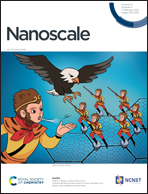Targeted brain tumor imaging by using discrete biopolymer-coated nanodiamonds across the blood–brain barrier†
Abstract
Short circulation lifetime, poor blood–brain barrier (BBB) permeability and low targeting specificity limit nanovehicles from crossing the vascular barrier and reaching the tumor site. Consequently, the precise diagnosis of malignant brain tumors remains a great challenge. This study demonstrates the imaging of photostable biopolymer-coated nanodiamonds (NDs) with tumor targeting properties inside the brain. NDs are labeled with PEGylated denatured bovine serum albumin (BSA) and tumor vasculature targeting tripeptides RGD. The modified NDs show high colloidal stability in different buffer systems. Moreover, it is found that discrete dcBSA-PEG-NDs cross the in vitro BBB model more effectively than aggregated NDs. Importantly, compared with the non-targeting NDs, RGD-dcBSA-PEG-NDs can selectively target the tumor site in U-87 MG bearing mice after systemic injection. Overall, this discrete ND system enables efficacious brain tumor visualization with minimal toxicity to other major organs, and is worthy of further investigation into the applications as a unique platform for noninvasive theragnostics and/or thermometry at different stages of human diseases in the brain.



 Please wait while we load your content...
Please wait while we load your content...